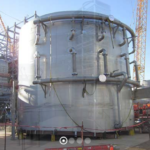Envirocare Gas Conditioning in Power Malaysia
Advanced Evaporative Gas Conditioning Systems Enhance Particulate Control for Power
 Evaporative Gas Conditioning (EGC) is a technique for conditioning flue gas prior to electrostatic precipitators and fabric filters to improve particulate collection. Unlike other flue gas conditioning techniques, EGC does not add any toxic or hazardous compounds to the plant site, flue gas, or collected ash. Instead, finely atomized water is evaporated in the gas stream to lower its temperature and raise the moisture content of the flue gas. This beneficially alters particulate properties by raising surface conduction and increasing inter-particle bonding, thereby enhancing the collection of dust and trace elements in particulate control devices.
Evaporative Gas Conditioning (EGC) is a technique for conditioning flue gas prior to electrostatic precipitators and fabric filters to improve particulate collection. Unlike other flue gas conditioning techniques, EGC does not add any toxic or hazardous compounds to the plant site, flue gas, or collected ash. Instead, finely atomized water is evaporated in the gas stream to lower its temperature and raise the moisture content of the flue gas. This beneficially alters particulate properties by raising surface conduction and increasing inter-particle bonding, thereby enhancing the collection of dust and trace elements in particulate control devices.
Dry Electrostatic Precipitators
In many applications, EPs fail to achieve specified collection efficiency. MicroMist EGCsystems efficiently add atomized water to increase the moisture content of the gas, resulting in reduced dust resistivity, reduced gas volume and improved electrical operation and precipitator performance.
Increased Precipitator SCA
SCA is the ratio of collecting plate surface area to gas volume. The higher the SCA the greater the collection efficiency. By reducing the gas temperature, gas volume is decreased. Even relatively small reductions in gas volume can increase a precipitator’s SCA, dramatically reducing emissions.
Improved Dust Resistivity
EnviroCare MicroMist EGC adds moisture, thereby reducing dust resistivity, resulting in greater particulate collection and improved electrical operation. With reduced dust resistivity, energy can be applied more efficiently, reducing sparking and thereby decreasing the energy spent in recharging the fields. This results in steady precipitator operation, minimal sparking, reduced power consumption and considerable savings in maintenance.
Re-Entraiment Control
A portion of the particulate emissions from precipitators can be attributed to the dust that has been precipitated onto the collecting plates and then released into the gas stream. This is referred to as particulate re-entrainment. These particles are either scoured off, electostatically repelled, or re-entrained into the gas stream during rapping. By increasing SCA, reducing gas volume and improving electrical conductivity, particulate re-entrainment is greatly reduced.
Fabric Filter
Fabric filter dust collectors are often chosen for their efficiency in collecting particulate. Unfortunately, high gas temperatures require the use of expensive filter bags that still may be limited to lower gas temperature than many processes require. EnviroCare MicroMist EGC is beneficial to the performance of the fabric filter by reducing gas volume and thereby lowering the air-to-cloth ratio.
Improved Air-to-Cloth Ratio
The cooling of gases through water droplet evaporation is beneficial to fabric filters. The lower gas volume means lower filter face velocity, also called air-to-cloth ratio. Lowering the air-to-cloth ratio increases production while maintaining the same collection efficiency or reducing emissions.
Decreased Pressure Drop
EnviroCare MicroMist EGC effectively lowers the pressure drop across a fabric filter by lowering the filter drag through the filter cake. Large reductions in drag can now be achieved through moisture conditioning. The mechanism for the reduction in drag is the higher cake porosity. This porosity is increased because water absorbed onto the dust strengthens particle-to-particle bonding so that the resulting agglomeration structure is more open. Pressure drop is proportional to the air-to-cloth ratio. For many fabric filters the pressure drop is typically three times the air-to-cloth ratio. The combination of lowering the air-to-cloth ratio and lowering the filter drag dramatically reduces the pressure drop across the dust collector.


